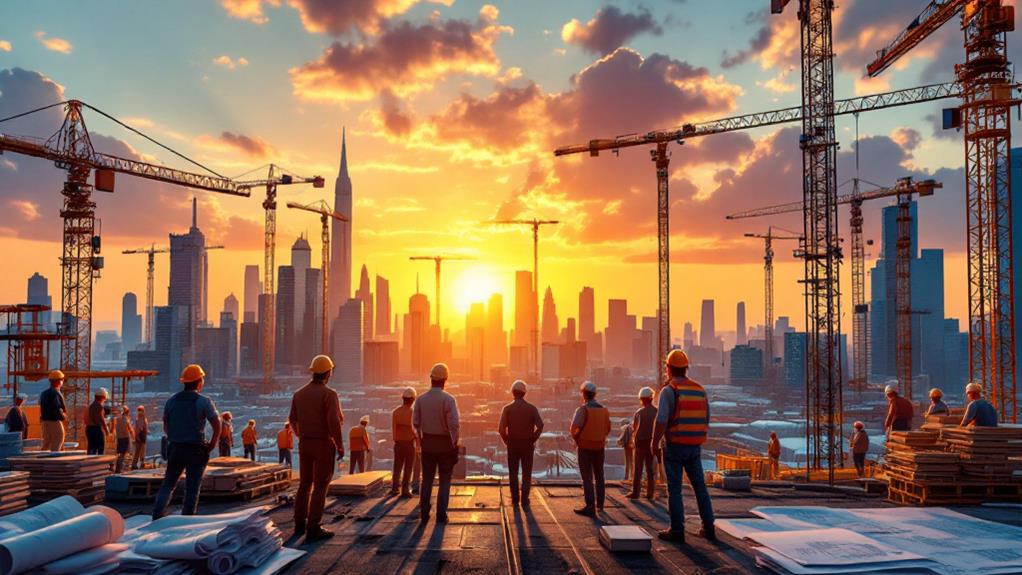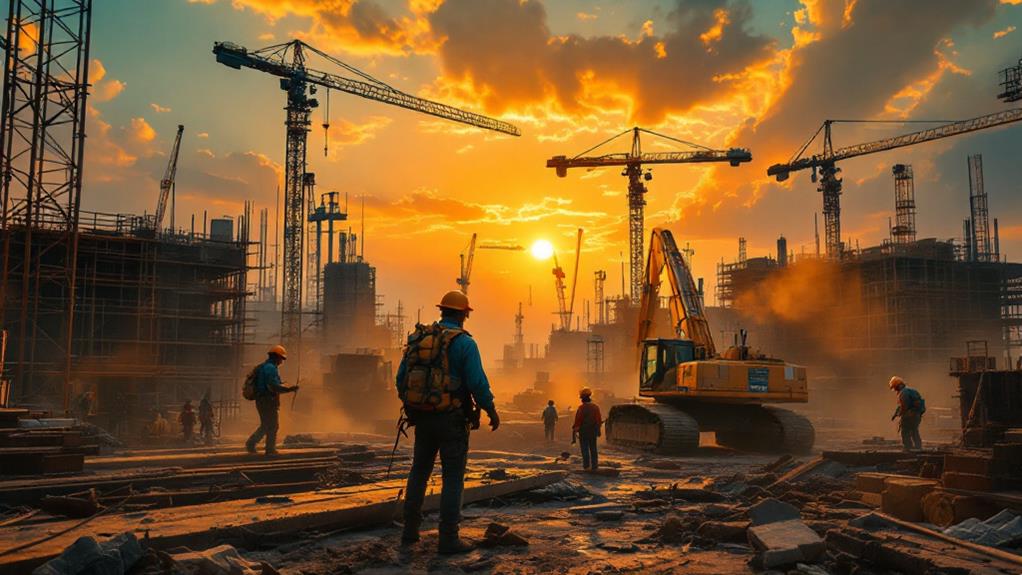The Most Ambitious Construction Projects in History

You're about to uncover some of the most ambitious construction projects in history. These megaprojects push the boundaries of innovation and human collaboration. From the timeless majesty of the Great Pyramid of Giza to the towering Burj Khalifa, humans have always reached for the skies. Marvel at the engineering triumphs of the Great Wall of China and the Panama Canal, both of which transformed landscapes. In the modern world, efforts like the International Space Station and Bhadla Solar Park showcase our commitment to sustainability and exploration. Prepare to be amazed by even more feats of ingenuity and bold vision.
Defining Megaprojects
Encompassing vast scales and complexities, megaprojects stand as monumental endeavors in the world of construction. These ambitious projects, with costs exceeding US$1 billion, often comprise infrastructure projects like bridges, highways, railways, airports, and power plants. They require a blend of technological advancement and global collaboration, drawing expertise and resources from around the world. For you, understanding their impact means recognizing how they drive economic growth through job creation and substantial economic investment.
Megaprojects aren't just about economic benefits; they also demand careful environmental considerations. As you explore their planning and execution, it's essential to evaluate how these projects affect natural ecosystems and local communities. Balancing development with environmental sustainability is a challenge, especially when megaprojects involve renewable energy sources, which aim to minimize ecological footprints.
In the construction industry, these projects symbolize innovation and progress, pushing the boundaries of what's possible. They don't just transform landscapes but also redefine how societies interact with their environments. By fostering global collaboration and focusing on long-term benefits, megaprojects have the potential to reshape entire regions, making them significant in discussions about future infrastructure and sustainable development.
Iconic Architectural Feats
Megaprojects redefine landscapes and societies, and some of the most iconic architectural feats throughout history serve as exceptional examples of this transformative power. The Great Pyramid of Giza, with its towering presence, held the title of the tallest man-made structure for 3,800 years. Its construction showcases ancient engineering precision and architectural brilliance, aligning perfectly with the cardinal points. The Burj Khalifa, the tallest building in the world, stands as a reflection of modern innovation and collaboration. Completed in 2010, this architectural marvel in Dubai required an estimated investment of $15 billion, setting multiple world records.
The Great Wall of China, stretching over 13,000 miles, exemplifies extraordinary manpower and engineering, adapting to the natural landscape over centuries. The Sydney Opera House, with its unique shell-like design, represents architectural innovation and cultural significance, standing as an iconic symbol of Australia. Finally, the Eiffel Tower, initially criticized, now stands as a beloved emblem of French engineering and design.
- Great Pyramid of Giza: Ancient precision and engineering
- Burj Khalifa: Modern tallest building
- Great Wall of China: Extensive engineering feat
- Sydney Opera House: Iconic design
- Eiffel Tower: French architectural symbol
These structures inspire awe and admiration, transcending time and geography.
Pioneering Transportation Initiatives

When you think of transformative transportation projects, pioneering initiatives like the Channel Tunnel and the Panama Canal come to mind. The Channel Tunnel, completed in 1994, altered rapid rail travel by connecting the UK and France under the English Channel. Spanning 31.4 miles, it's a marvel of engineering, facilitating seamless cross-border travels. On the other hand, the Panama Canal, finished in 1914, changed maritime travel by linking the Atlantic and Pacific Oceans, drastically reducing travel time for over 14,000 vessels annually. This canal underscores its crucial role in global trade and remains one of the most significant construction projects in history.
Looking east, China's Gulf Railway aims to connect six Gulf Cooperation Council countries over 1,300 kilometers, enhancing regional goods and passenger movement. Scheduled for completion before 2030, it's set to further integrate the region's transportation network. Meanwhile, the Hong Kong-Zhuhai-Macao Bridge, completed in 2018, spans 14.2 miles, incorporating artificial islands to bolster infrastructure and customs efficiency. In the U.S., the California High-Speed Rail seeks to slash travel time between San Francisco and Los Angeles to 2.5 hours, representing a landmark in American rail initiatives. These ambitious projects showcase the ongoing evolution of transportation initiatives worldwide.
Renewable Energy Innovations
In the domain of renewable energy, advancement drives the creation of some of the world's most impressive solar projects. You'll find solar power plants like the Bhadla Solar Park in Rajasthan, India, which not only holds a capacity of 2,245 MW but also showcases groundbreaking building practices. Such projects are vital in reducing carbon emissions and addressing environmental concerns. The Benban Solar Park in Egypt, with its 1,500 MW capacity, stands as a demonstration of the country's commitment to renewable energy and green energy solutions.
- Bhadla Solar Park, India: 2,245 MW capacity, $1.5 billion investment.
- Benban Solar Park, Egypt: 1,500 MW capacity, $3.5 - $4 billion investment.
- Khavda Solar Park, India: Future site of the world's largest solar plant.
- Pavagada Solar Park, India: 2,050 MW capacity, completed in 2019.
- Noor Abu Dhabi, UAE: 1,177 MW capacity, completed in 2019.
These solar energy projects also focus on sustainable water use and effective water management. As some of the largest construction projects globally, they play a significant role in shaping a sustainable future. By embracing green energy, these initiatives pave the way for a world less reliant on fossil fuels, contributing to a healthier planet.
Space and Research Ventures

Among the most ambitious endeavors in human history, space and research ventures stand out for their complexity and potential to transform our understanding of the universe. The International Space Station (ISS) is a prime example, representing a monumental collaborative effort among NASA, Roscosmos, ESA, JAXA, and CSA. With a staggering construction cost of $150 billion, the ISS facilitates groundbreaking research that spans multiple scientific disciplines.
Similarly, the Large Hadron Collider (LHC) is a marvel of modern engineering and scientific initiative. As the world's largest particle accelerator, built for around $6 billion, it enables physicists to investigate the fundamental particles of the universe. On the front of energy, the ITER project in France aims to reveal nuclear fusion, offering the promise of large-scale, carbon-free energy. With an estimated budget reaching up to €65 billion, ITER is one of the most ambitious construction projects in pursuit of sustainable energy.
Astronomical observations will leap forward with the Giant Magellan Telescope in Chile, a $2 billion endeavor slated for completion in 2025. These large-scale projects exemplify human ingenuity and our relentless quest for knowledge, reshaping scientific frontiers.
Future Prospects in Construction
The construction industry's future is set to undergo a transformative journey, driven by a projected 7.5% annual growth rate from 2023 to 2030. As urban areas swell, the demand for sustainable construction practices becomes paramount. By 2050, the need to construct 13,000 buildings daily underscores the urgency of adopting advanced technologies. Building Information Modeling (BIM) and modular construction offer pathways to improve construction efficiency, reduce waste, and cut costs. With infrastructure development at the forefront, integrating renewable energy solutions is poised to rise, aiming for zero carbon emissions.
However, the industry faces challenges like labor shortages and supply chain disruptions, necessitating creativity and automation. Projects like NEOM City, which seeks 100% renewable energy, exemplify the shift towards sustainable practices. As you navigate the evolving landscape, consider these transformative elements:
- Urban Expansion: Rapid growth in urban areas requires creative infrastructure solutions.
- Sustainable Practices: Adopt renewable energy and zero carbon strategies.
- Technological Integration: Utilize advanced technologies like BIM and modular approaches.
- Efficiency Improvement: Prioritize methods that increase construction efficiency.
- Addressing Labor Gaps: Investigate automation and new techniques to combat labor shortages.
The future holds immense potential for a more efficient and sustainable construction industry.



